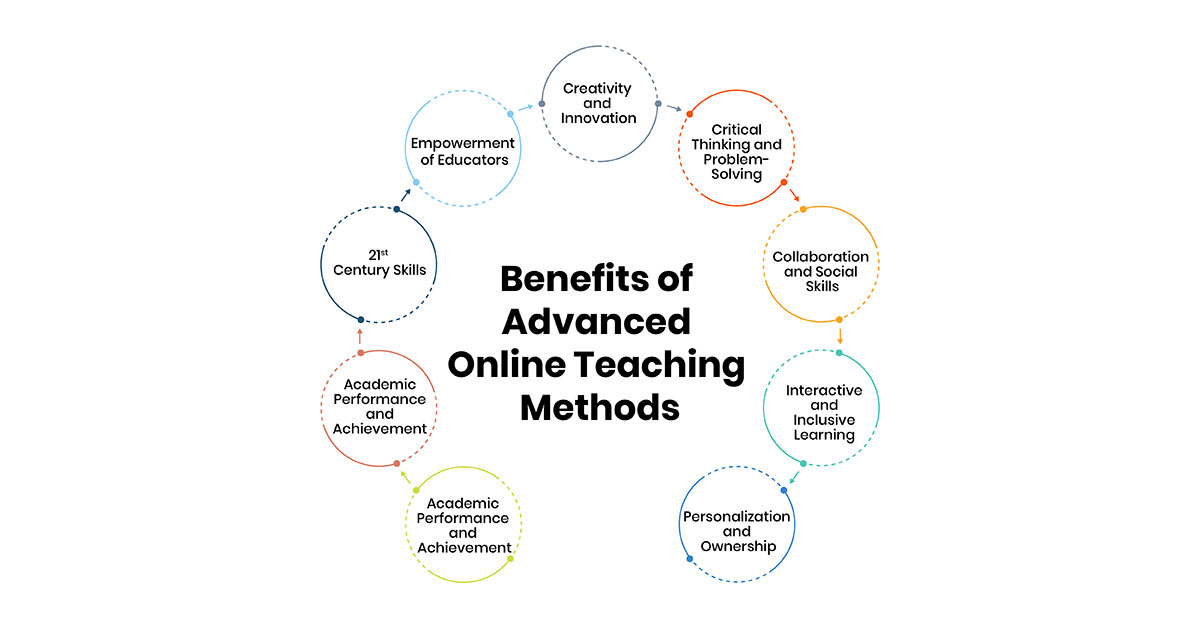Advancements in Online Learning: 13 Contemporary Teaching Approaches
May 17, 2024In recent years, online education has emerged as a powerful alternative to traditional classroom learning, offering efficient and engaging ways to access knowledge. With advancements in technology and the growing demand for flexible learning options, the landscape of education has evolved significantly. This evolution has brought about a plethora of modern teaching methods designed specifically for the online environment.
From gamification and project-based learning to the integration of artificial intelligence and virtual reality, these innovative approaches aim to enhance student engagement, improve learning outcomes, and make education more accessible and convenient.
Whether you're an elementary teacher, a professor in higher education, or an online instructor, staying abreast of these cutting-edge teaching methods is essential for delivering effective instruction and keeping learners engaged.
13 Modern Teaching Methods Revolutionizing Online Education
Today’s education system is experiencing significant changes due to advancements in technology and the increased need for flexible learning. This has led to the development of numerous teaching techniques modified explicitly for online education platforms, all geared towards improving student participation, motivation, and better academic outcomes.
Now let us have a closer look at some of them:

-
Flipped Classroom
The Flipped Classroom approach revolutionizes traditional teaching by reversing the learning sequence. Students independently access pre-recorded lectures or reading materials before class, allowing class time to be dedicated to interactive discussions and activities facilitated by educators. This method stimulates a dynamic and participatory learning environment, promoting deeper comprehension and active engagement. -
Tactile Learning
Also known as kinesthetic learning, revolutionizes education by emphasizing physical engagement and hands-on experiences, even in online settings. Through interactive demonstrations and practical activities led by instructors, learners actively participate in tasks from their own place of comfort.This method is especially effective for subjects requiring practical skill development or hands-on experimentation as it leverages the sense of touch to explore concepts and materials.
-
Project-Based Learning
Project-Based Learning immerses students in real-world projects that require critical thinking and problem-solving skills. Students create tangible outcomes such as presentations, reports, or multimedia projects showcasing project results.It often integrates technology tools and digital resources to facilitate communication and project management among students and teachers. By tackling practical challenges, students deepen their understanding of course material and develop valuable communication and teamwork abilities essential for success in the modern workforce.
-
Problem-Based Learning
Problem-Based Learning presents students with a problem before teaching relevant concepts, that mimics authentic situations they may encounter in their field of study or professional practice, encouraging independent exploration and collaboration. They then work together, often in virtual teams, to analyze the problem, identify relevant information, generate hypotheses, and develop solutions through inquiry and discovery. -
Inquiry-Based Learning
Inquiry-Based Learning stimulates curiosity and independent thinking by presenting open-ended inquiries for investigation. In this method, students are encouraged to ask questions, explore topics of interest, and seek answers independently or collaboratively with peers. Students explore and theorize, fostering creativity and resourcefulness while honing their analytical abilities and research skills. -
Collaborative Learning
Collaborative Learning emphasizes teamwork and peer interaction, allowing students to learn from one another and develop essential soft skills such as communication, leadership, and time management. By working together on projects and activities, students deepen their understanding and build a sense of community. -
Cooperative Learning
Similar to collaborative learning, Cooperative Learning assigns specific roles and tasks to each student within small groups. It involves collaborative efforts among students who interact virtually through online platforms, such as discussion forums, video conferencing, or shared documents. This method promotes accountability and responsibility while cultivating a sense of teamwork and collective achievement. -
Game-Based Learning
Game-Based Learning integrates gaming elements into educational content, making learning more engaging and interactive. It involves the use of digital games, simulations, and interactive activities to teach and reinforce academic concepts and skills. By incorporating rewards and challenges, this method motivates students to actively participate and strive for improvement while reinforcing learning objectives. -
VAK Learning
VAK Learning accommodates different learning styles by incorporating visual, auditory, and kinesthetic elements into lessons. In this method, educators utilize various multimedia tools and techniques to engage learners through visual representations (such as images, diagrams, and videos), auditory cues (such as lectures, podcasts, and discussions), and kinesthetic activities (such as interactive simulations, virtual labs, and hands-on exercises).This inclusive approach ensures that all students can effectively absorb and retain information, catering to individual preferences and strengths.
-
Thinking-Based Learning
Thinking-Based Learning encourages critical thinking and self-reflection, challenging students to question assumptions and analyze their own learning processes. It involves activities and exercises designed to challenge students' reasoning abilities, encourage deep reflection, and promote higher-order thinking. By inculcating metacognitive skills, this method promotes deeper understanding and lifelong learning. -
Competency-Based Learning
Competency-Based Learning focuses on mastery of specific skills or competencies, allowing students to progress at their own pace based on demonstrated proficiency. Assessment is often competency-based as well, with learners evaluated based on their ability to perform specific tasks or meet predetermined learning objectives. This personalized approach promotes deeper learning and empowers students to take ownership of their educational journey. -
Independent Learning
Independent learning is where individuals take control of their own learning process and pace through digital platforms and resources without direct supervision from an instructor. It facilitates autonomy and self-directedness. They manage their study schedule, set goals, and track their progress independently, relying on self-discipline and motivation to stay engaged and achieve learning objectives. Educators provide support and guidance as needed, allowing students to explore their interests and pursue personalized learning paths. -
Adaptive Learning
Adaptive Learning leverages artificial intelligence and machine learning algorithms to personalize the learning experience. Through the use of algorithms and data analytics, online adaptive learning platforms continually assess a student's performance and adjust the content, pace, and difficulty level of the material accordingly. By adapting to each student's individual needs and pace of learning, this method ensures optimal engagement and mastery of course material.
By embracing innovation and adopting a learner-centered approach, educators can create dynamic and engaging learning experiences that empower students to succeed in an increasingly complex and interconnected world.
Benefits of Advanced Online Teaching Methods
In this exploration of the benefits of modern teaching methods, we delve into how these approaches empower both students and educators in today's educational scenario.

-
Engagement and Motivation
Modern teaching methods actively involve students in the learning process, bringing higher levels of engagement and motivation. By incorporating interactive elements and real-world applications, these methods make learning more dynamic and compelling. -
Creativity and Innovation
Encouraging creative thinking and innovation is a hallmark of these teaching methods. Through activities that prompt students to explore, experiment, and problem-solve, these methods stimulate creativity and inspire students to think outside the box. -
Critical Thinking and Problem-Solving
The development of critical thinking and problem-solving skills is prioritized. By presenting challenges and encouraging students to analyze, evaluate, and devise solutions, these methods equip students with essential cognitive abilities. -
Collaboration and Social Skills
Collaboration promotes teamwork and social interaction among students. By working together on projects and activities, students develop communication skills, empathy, and a sense of collective responsibility. -
Interactive and Inclusive Learning
Through multimedia resources, online platforms, and adaptive learning tools, these methods cater to diverse learning styles and ensure that every student can participate and succeed. -
Personalization and Ownership
By allowing students to progress at their own pace, pursue areas of interest, and take control of their learning journey, these methods empower students and foster a sense of ownership over their education. -
Academic Performance and Achievement
Aligned with educational standards and learning objectives, modern teaching methods have been shown to improve academic performance and achievement outcomes. -
21st Century Skills
These focuses on cultivating 21st-century skills that are vital for success in the digital age. From digital literacy and information fluency to critical thinking and global awareness, these methods prepare students to thrive in an ever-evolving world. -
Empowerment of Educators
Modern teaching techniques empowers educators to innovate and adapt their teaching practices to meet the needs of today's learners. By providing access to a diverse range of instructional tools and resources, these methods enable educators to create impactful and meaningful learning experiences for their students.
Conclusion
The evolution of online education has ushered in a new era of learning, characterized by innovation, engagement, and empowerment. Through a diverse array of modern teaching methods, educators are equipped with the tools and strategies to inspire students and cultivate essential skills for success in the digital age. Together, we can harness the power of technology and pedagogy to shape the future of education and unlock the full potential of every learner.




